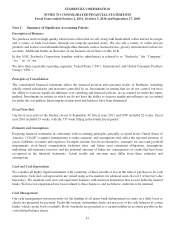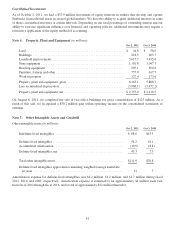Starbucks 2011 Annual Report Download - page 58
Download and view the complete annual report
Please find page 58 of the 2011 Starbucks annual report below. You can navigate through the pages in the report by either clicking on the pages listed below, or by using the keyword search tool below to find specific information within the annual report.CPG, Foodservice and Other Revenues
CPG, foodservice and other revenues primarily consist of packaged coffee and tea sales to grocery and warehouse
club stores, revenues from sales of products to and license revenues from manufacturers that produce and market
Starbucks and Seattle’s Best Coffee branded products through licensing agreements, and sales to our national
foodservice accounts. Sales of coffee, tea and related products to grocery and warehouse club stores are generally
recognized when received by the customer or distributor, depending on contract terms. We maintain a sales return
allowance to reduce packaged goods revenues for estimated future product returns based on historical patterns.
Revenues are recorded net of sales discounts given to customers for trade promotions and payments to customers for
product placement in our customers’ stores.
Revenues from sales of products to manufacturers that produce and market Starbucks and Seattle’s Best Coffee
branded products through licensing agreements are generally recognized when the product is received by the
manufacturer or distributor. License revenues from manufacturers are based on a percentage of sales and are
recognized on a monthly basis when earned. National foodservice account revenues are recognized when the
product is received by the customer or distributor.
Advertising
Our annual marketing expenses include many components, one of which is advertising costs. We expense most
advertising costs as they are incurred, except for certain production costs that are expensed the first time the
advertising campaign takes place.
Advertising expenses totaled $141.4 million, $176.2 million, and $126.3 million in fiscal 2011, 2010, and 2009,
respectively.
Store Preopening Expenses
Costs incurred in connection with the start-up and promotion of new store openings are expensed as incurred.
Operating Leases
We lease retail stores, roasting, distribution and warehouse facilities, and office space under operating leases. Most
lease agreements contain tenant improvement allowances, rent holidays, lease premiums, rent escalation clauses
and/or contingent rent provisions. For purposes of recognizing incentives, premiums and minimum rental expenses
on a straight-line basis over the terms of the leases, we use the date of initial possession to begin amortization, which
is generally when we enter the space and begin to make improvements in preparation of intended use.
For tenant improvement allowances and rent holidays, we record a deferred rent liability on the consolidated balance
sheets and amortize the deferred rent over the terms of the leases as reductions to rent expense on the consolidated
statements of earnings.
For premiums paid upfront to enter a lease agreement, we record a deferred rent asset on the consolidated balance
sheets and then amortize the deferred rent over the terms of the leases as additional rent expense on the consolidated
statements of earnings.
For scheduled rent escalation clauses during the lease terms or for rental payments commencing at a date other than
the date of initial occupancy, we record minimum rental expenses on a straight-line basis over the terms of the leases
on the consolidated statements of earnings.
Certain leases provide for contingent rents, which are determined as a percentage of gross sales in excess of
specified levels. We record a contingent rent liability on the consolidated balance sheets and the corresponding rent
expense when specified levels have been achieved or when we determine that achieving the specified levels during
the fiscal year is probable.
52
























